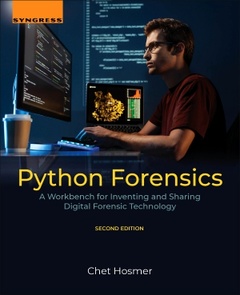Python Forensics (2nd Ed.) A Workbench for Inventing and Sharing Digital Forensic Technology
Auteur : Hosmer Chet

Python Forensics: A Workbench for Inventing and Sharing Digital Forensic Technology, Second Edition provides never-before-published, proven forensic modules, libraries, and turnkey solutions. In addition, detailed instruction and documentation provided with the code samples allow even novice Python programmers to add their own unique twists. Rapid development of new cybercrime investigation tools is an essential ingredient in virtually every case and environment. Whether you are performing post-mortem investigation, executing live triage, extracting evidence from mobile devices or cloud services, or are collecting and processing evidence from a network, Python forensic implementations can fill in the gaps. This updated edition addresses new and emerging needs of the Digital Forensics professional, including expanded integration of Python into forensics and cybersecurity platforms; extensive machine learning integration with the Python ecosystem; using Python for deep packet inspection investigations; using Python for the gathering and analysis of Open-Source Intelligence (OSINT) investigations; using Python during eDiscovery investigations; integration of Python with Generative Pre Trainer-Transformers such as GPT-3, ChatGPT, and others; extraction and interaction with social media platforms; integration and access to Virus Total and other Internet resources; and YARA rule processing with Python.
2. Integrating advanced 3rd Party Libraries for Machine Learning, Natural Language Processing, eDiscovery, GPT, social media and malware investigations
3. Integrating Python with forensics and cyber security platforms
4. Forensics Searching using regular expressions, YARA rules, targeting static and dynamic environments including Web and Social Platforms
5. Analysis of photographic images for the identification of fake photos, deep fake videos/audio, and data hiding methods
6. Extracting and analyzing time of static and dynamic evidence sources including social platforms
7. Extracting meaning and sentiment from news stories, tweets, and other social media communications
8. Performing packet capture and deep packet analysis
9. Gathering open-source intelligence from social platforms and eDiscovery applications
10. Python Forensics in the Cloud
11. Integrating Python with GPT-3 and ChatGPT
12. Applying Python and Machine Learning within forensic investigations. Identifying fake news, Spear Phishing, GPT generated text, echo chambers, and propaganda
13. What is ahead for Python and Forensics
- Provides hands-on tools, code samples, and detailed instruction and documentation that can be put to use immediately
- Discusses how to create a Python forensics workbench
- Covers effective forensic searching and indexing using Python
- Shows how to use Python to examine mobile device operating systems
- Delves into extensive machine learning integration with the Python ecosystem, integration of Python with Generative Pre Trainer-Transformers such as GPT-3, ChatGPT, and other new and emerging applications of Python to digital forensics
Date de parution : 11-2024
Ouvrage de 400 p.



